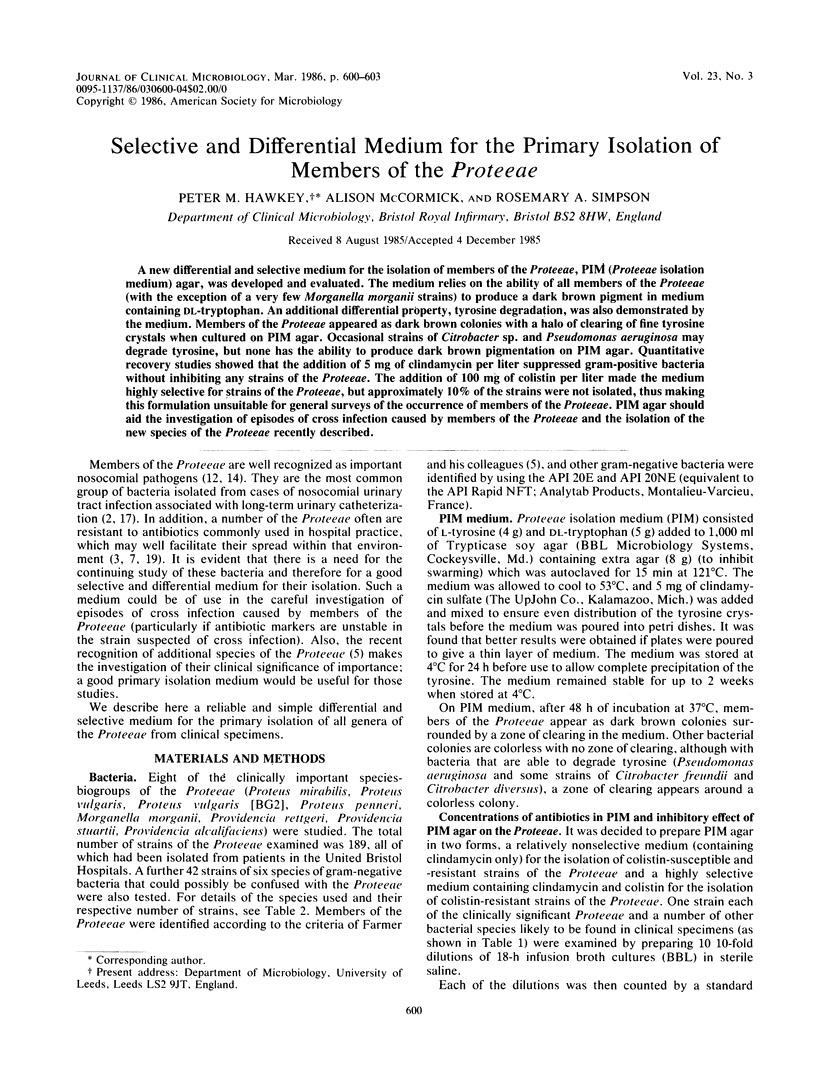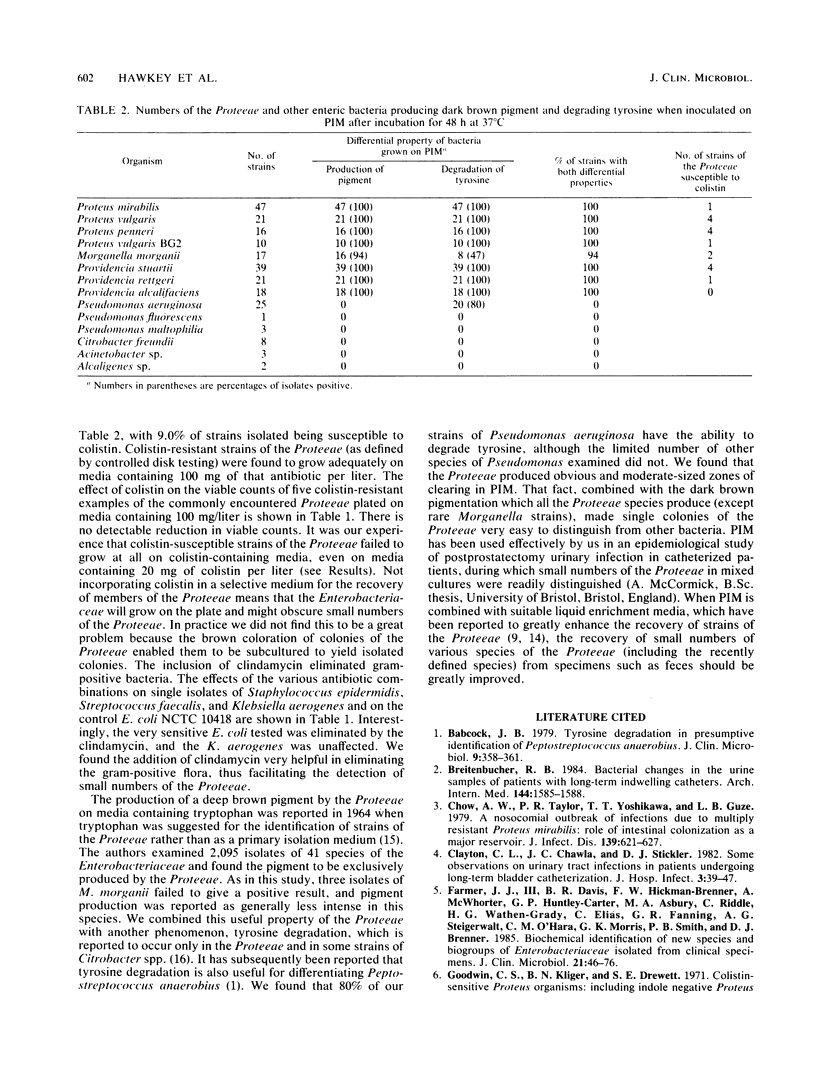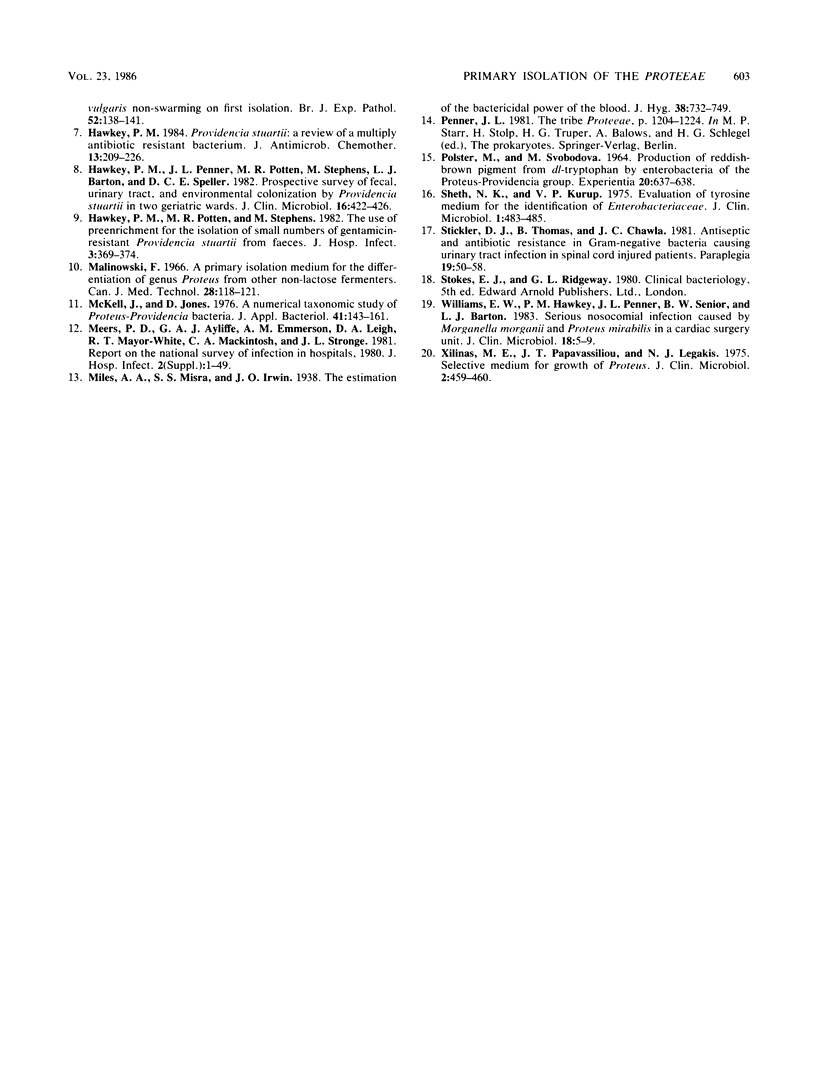Abstract
A new differential and selective medium for the isolation of members of the Proteeae, PIM (Proteeae isolation medium) agar, was developed and evaluated. The medium relies on the ability of all members of the Proteeae (with the exception of a very few Morganella morganii strains) to produce a dark brown pigment in medium containing DL-tryptophan. An additional differential property, tyrosine degradation, was also demonstrated by the medium. Members of the Proteeae appeared as dark brown colonies with a halo of clearing of fine tyrosine crystals when cultured on PIM agar. Occasional strains of Citrobacter sp. and Pseudomonas aeruginosa may degrade tyrosine, but none has the ability to produce dark brown pigmentation on PIM agar. Quantitative recovery studies showed that the addition of 5 mg of clindamycin per liter suppressed gram-positive bacteria without inhibiting any strains of the Proteeae. The addition of 100 mg of colistin per liter made the medium highly selective for strains of the Proteeae, but approximately 10% of the strains were not isolated, thus making this formulation unsuitable for general surveys of the occurrence of members of the Proteeae. PIM agar should aid the investigation of episodes of cross infection caused by members of the Proteeae and the isolation of the new species of the Proteeae recently described.
Full text
PDF



Selected References
These references are in PubMed. This may not be the complete list of references from this article.
- Babcock J. B. Tyrosine degradation in presumptive identification of Peptostreptococcus anaerobius. J Clin Microbiol. 1979 Mar;9(3):358–361. doi: 10.1128/jcm.9.3.358-361.1979. [DOI] [PMC free article] [PubMed] [Google Scholar]
- Breitenbucher R. B. Bacterial changes in the urine samples of patients with long-term indwelling catheters. Arch Intern Med. 1984 Aug;144(8):1585–1588. [PubMed] [Google Scholar]
- Chow A. W., Taylor P. R., Yoshikawa T. T., Guze L. B. A nosocomial outbreak of infections due to multiply resistant Proteus mirabilis: role of intestinal colonization as a major reservoir. J Infect Dis. 1979 Jun;139(6):621–627. doi: 10.1093/infdis/139.6.621. [DOI] [PubMed] [Google Scholar]
- Clayton C. L., Chawla J. C., Stickler D. J. Some observations on urinary tract infections in patients undergoing long-term bladder catheterization. J Hosp Infect. 1982 Mar;3(1):39–47. doi: 10.1016/0195-6701(82)90029-9. [DOI] [PubMed] [Google Scholar]
- Farmer J. J., 3rd, Davis B. R., Hickman-Brenner F. W., McWhorter A., Huntley-Carter G. P., Asbury M. A., Riddle C., Wathen-Grady H. G., Elias C., Fanning G. R. Biochemical identification of new species and biogroups of Enterobacteriaceae isolated from clinical specimens. J Clin Microbiol. 1985 Jan;21(1):46–76. doi: 10.1128/jcm.21.1.46-76.1985. [DOI] [PMC free article] [PubMed] [Google Scholar]
- Goodwin C. S., Kliger B. N., Drewett S. E. Colistin-sensitive Proteus organisms: including indole-negative Proteus vulgaris, non-swarming on first isolation. Br J Exp Pathol. 1971 Apr;52(2):138–141. [PMC free article] [PubMed] [Google Scholar]
- Hawkey P. M., Penner J. L., Potten M. R., Stephens M., Barton L. J., Speller D. C. Prospective survey of fecal, urinary tract, and environmental colonization by Providencia stuartii in two geriatric wards. J Clin Microbiol. 1982 Sep;16(3):422–426. doi: 10.1128/jcm.16.3.422-426.1982. [DOI] [PMC free article] [PubMed] [Google Scholar]
- Hawkey P. M., Potten M. R., Stephens M. The use of pre-enrichment for the isolation of small numbers of gentamicin-resistant Providencia stuartii from faeces. J Hosp Infect. 1982 Dec;3(4):369–374. doi: 10.1016/0195-6701(82)90070-6. [DOI] [PubMed] [Google Scholar]
- Hawkey P. M. Providencia stuartii: a review of a multiply antibiotic-resistant bacterium. J Antimicrob Chemother. 1984 Mar;13(3):209–226. doi: 10.1093/jac/13.3.209. [DOI] [PubMed] [Google Scholar]
- Malinowski F. A primary isolation medium. For the differentiation of genus Proteus from other non-lactose and lactose fermenters. Can J Med Technol. 1966 Jun;28(3):118–121. [PubMed] [Google Scholar]
- McKell J., Jones D. A numerical taxonomic study of Proteus-Providence bacteria. J Appl Bacteriol. 1976 Aug;41(1):143–161. doi: 10.1111/j.1365-2672.1976.tb00614.x. [DOI] [PubMed] [Google Scholar]
- Polster M., Svobodová M. Production of reddish-brown pigment from dl-tryptophan by enterobacteria of the Proteusprovidencia group. Experientia. 1964 Nov 15;20(11):637–638. doi: 10.1007/BF02144835. [DOI] [PubMed] [Google Scholar]
- Rogers K. B. Face masks: which, when, where and why? J Hosp Infect. 1981 Mar;2(1):1–4. doi: 10.1016/0195-6701(81)90001-3. [DOI] [PubMed] [Google Scholar]
- Sheth N. K., Kurup V. P. Evaluation of tyrosine medium for the identification of Enterobacteriaceae. J Clin Microbiol. 1975 May;1(5):483–485. doi: 10.1128/jcm.1.5.483-485.1975. [DOI] [PMC free article] [PubMed] [Google Scholar]
- Stickler D. J., Thomas B., Chawla J. C. Antiseptic and antibiotic resistance in gram-negative bacteria causing urinary tract infection in spinal cord injured patients. Paraplegia. 1981;19(1):50–58. doi: 10.1038/sc.1981.13. [DOI] [PubMed] [Google Scholar]
- Williams E. W., Hawkey P. M., Penner J. L., Senior B. W., Barton L. J. Serious nosocomial infection caused by Morganella morganii and Proteus mirabilis in a cardiac surgery unit. J Clin Microbiol. 1983 Jul;18(1):5–9. doi: 10.1128/jcm.18.1.5-9.1983. [DOI] [PMC free article] [PubMed] [Google Scholar]
- Xilinas M. E., Papavassiliou J. T., Legakis N. J. Selective medium for growth of Proteus. J Clin Microbiol. 1975 Nov;2(5):459–460. doi: 10.1128/jcm.2.5.459-460.1975. [DOI] [PMC free article] [PubMed] [Google Scholar]


